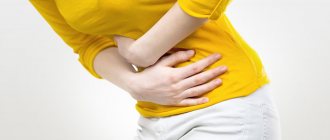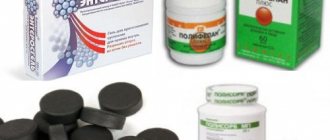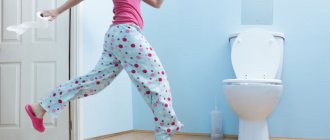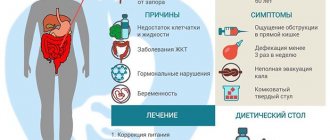- Causes of constipation in adults
- Treatment of constipation in adults
- Remedies for constipation in adults
- Preventing constipation in adults
Constipation is a symptom of impaired bowel function.
We can talk about constipation when problems or lack of bowel movements continue for more than a day. The appearance of constipation makes unpleasant adjustments to our plans. This especially affects working adults, since chronic constipation can significantly reduce productivity and contribute to the development of stress. Almost half of the world's population experiences constipation from time to time, of which 2% have a chronic form. Due to the characteristics of a modern sedentary lifestyle, snacking on the go and other unfavorable factors, constipation takes an “honorable” place among diseases in the modern world. And in old age, the number and duration of constipation, unfortunately, may increase.
What is constipation
Today we will not talk about the famous compact car “Zaporozhets”, which people jokingly called “constipation”, but about the painful condition of the gastrointestinal tract.
So, constipation in the medical sense is too infrequent or insufficient bowel movements. However, constipation is not considered an independent disease. It is classified as a symptom that allows us to talk about diseases, dysfunctions of body systems and even its pathologies. According to statistics, half of the adult population of the planet suffers from this unpleasant symptom. However, some do not take the problem seriously enough. But in vain!
Chronic constipation
Constipation , or constipation (constipatio - lat.) is a chronic intestinal dysfunction characterized by longer than normal intervals between bowel movements, difficulty defecating, insufficient bowel movements and hardening of the stool.
The frequency of bowel movements (defecations) in practically healthy individuals can fluctuate within fairly wide limits. For example, more than half of adults have a bowel movement once a day. Less common are individuals with a frequency of bowel movements 2 times a day or 3 times every 2 days (5-9% of healthy people). In the case of a physiological (normal) increase or decrease in the frequency of bowel movements, there are no unpleasant sensations or difficulties before, during and after bowel movements. The feces are well-formed, without any particular odor or visible impurities (mucus, blood, pus, undigested food residues).
What types of constipation are there?
1. Primary constipation (with intestinal diseases)
A. Functional constipation (or habitual):
- rectal constipation (dyschezia) - a sharp weakening or disappearance of the defecation reflex;
- cologenic constipation is a slowdown in the intestinal passage of chyme as a manifestation of dyskinetic disorders in irritable bowel syndrome.
B. Organic constipation. Develops with structural lesions of the intestine:
- colitis;
- intestinal dysbiosis;
- anal fissure, hemorrhoids, etc.;
- cicatricial changes in the colon;
- prolapse of the perineum and prolapse of the rectal mucosa:
- malignant and benign intestinal tumors;
- elongated large intestine (dolichosigma);
- idiopathic megacolon and other diseases
2. Secondary constipation (caused by extraintestinal causes)
a) reflex (for peptic ulcers, cholecystitis, nephrolithiasis, gynecological diseases, etc.)
b) for diseases of the endocrine (hypothyroidism, diabetes mellitus, etc.) and nervous system (spinal cord diseases, parkinsonism, etc.).
c) metabolic and toxic (porphyria, lead poisoning, taking anticholinergics, ganglion blockers, iron supplements, diuretics, sedatives and other medications)
d) muscle constipation - it is caused by conditions leading to damage to the muscles (diaphragm, abdominal wall, anus) involved in the passage of feces and the act of defecation: myopathies, scleroderma, and other diseases
e) psychogenic
Diagnostic criteria for functional constipation (Rome, 1999)
Criteria include two or more of the following symptoms occurring for 12 weeks in a year
- Straining during defecation, taking up at least 1/4 of the time
- Fragmented and/or hard stool in at least one of the last four bowel movements
- A feeling of incomplete evacuation of intestinal contents at least during one of the last four bowel movements
- Sensation of obstruction during the passage of stool, in the case of one of the last four bowel movements
- The need to carry out manipulations to facilitate the act of defecation in more than one act of defecation out of four
- Reduce the number of bowel movements to less than three per week
To determine the cause of constipation, a number of examinations are necessary.
- To exclude the inflammatory process and anemia, a general blood test is performed.
- Blood sugar test to detect diabetes.
- Mandatory sigmoidoscopy, colonoscopy (if it is impossible to perform a colonoscopy, irrigoscopy, MRI colonoscopy), to exclude pathological processes in the intestines.
- Fibrogastroduodenoscopy – for the diagnosis of erosive and ulcerative processes in the esophagus, stomach, and duodenum. ,
- Ultrasound of the abdominal organs - to identify organic diseases of the digestive system.
- Analysis of feces for occult blood (before instrumental examination of the intestines),
- Coprocytogram - to determine the inflammatory process in the intestines,
- Analysis of feces for helminth eggs.
- Bacteriological examination of stool (stool analysis for dysbacteriosis) - to determine normal microflora and identify pathogenic and conditionally pathogenic intestinal microflora.
Treatment of chronic constipation requires a lot of effort, and, first of all, from the patient. Only with strict implementation of all recommendations is it possible to really achieve a positive effect. In the absence of indications for surgical treatment, the beginning of treatment, especially for atonic chronic constipation, is a change in diet.
Table 1. Basic foods that promote bowel movements
| Active beginning | Mechanism of laxative action | Products |
| Alimentary fiber | Swelling of fiber and increase in intestinal contents due to this | Wholemeal bread, cabbage, carrots, cucumbers, beets, spinach, zucchini, radishes, peas, beans, beans, dried fruits, oats, nuts |
| Levulose, dextrose, fructose | Strengthening the secretion of the digestive glands, stimulating peristalsis due to the formation of fermentation acids | Honey, cane and beet sugar, grapes, prunes, dried apricots, sweet varieties of apples, plums, pears, peaches, melon, pumpkin, gooseberries, blueberries, apricots, dates |
| Organic acids | Increased peristalsis | Fermented milk products, kvass, pickled and pickled vegetables, citrus fruits |
| Fatty polyunsaturated acids, fatty and essential oils | Excitation of peristalsis, facilitating the movement of intestinal contents, choleretic effect | Olive, sunflower, corn, soybean, palm oils, fish oil, nuts, spices |
If drug-free treatment methods do not help, then you need to consult a doctor to select a drug. Firstly, it is necessary to find out the cause of constipation in each specific case, and, secondly, independent uncontrolled use of laxatives, especially for a long time, can lead to serious complications. Side effects of such drugs include diarrhea, dehydration, inflammatory changes in the intestines with impaired parietal digestion, and decreased sensitivity of the receptor apparatus.
It is forbidden to take laxatives on your own if constipation is combined with abdominal pain, bloating, fever, blood in the stool, or weight loss.
Laxatives are divided into separate groups depending on their mechanism of action:
Osmotic laxatives are substances that help slow down the absorption of water and increase the volume of intestinal contents with subsequent irritation of intrareceptors. The most well-known drug in this group today is Forlax (the active substance is macrogol 4000). Due to its high molecular weight, forlax is not absorbed or metabolized in the gastrointestinal tract, and also does not cause structural changes in the colon and addiction. When taken regularly, Forlax has an important property for laxatives - it helps restore the natural urge to defecate and maintains regular bowel movements, without requiring an increase in dosage. The drug allows you to achieve a lasting therapeutic effect in patients of different ages. Does not interact with other drugs. The recommended dose is 4 sachets per day, in two doses. In this dosage, the drug is used until the first independent satisfactory act of bowel movement occurs, then the dose can be halved (1 sachet twice a day). This group also includes magnesium sulfate and Carlsbad salt. They are used in a dose of 15 to 50 g, depending on the desired result.
Poorly absorbed di- and oligosugars. Drugs in this group include lactulose, a synthetic disaccharide. Since lactulose is an indigestible disaccharide, it is practically not absorbed and has no side effects. The dose is selected individually for each patient and can range from 15 to 60 ml/day.
- Laxatives that enhance motility. Drugs in this group include bisacodyl, senna preparations, cisapride, microlax, etc.
Bisacodyl. The drug accelerates and enhances peristalsis by directly stimulating nerve endings in the mucous membrane of the colon, and also enhances mucus formation in the colon. Does not cause serious side effects. It can be prescribed at a dose of 5-15 mg per day; when taken per os, the effect occurs after 6-8 hours, when using rectal suppositories - after 15 minutes.
Senna preparations. Under the influence of drugs of this group, absorption of sodium and water ions from the intestinal lumen is inhibited, which leads to an increase in the volume of intestinal contents and increased intestinal motility. The drugs are not absorbed. It is recommended to take 1-3 tablets at night. The effect develops after 8-10 hours, stool returns to normal after a few days of regular use.
Cisapride. 5HT4 receptor agonist. The mechanism of action is associated with an increase in the release of acetylcholine from the endings of the cholinergic nerves of the mesenteric plexuses of the intestine and an increase in the sensitivity of the M-cholinergic receptors of the smooth muscles of the intestine to it; the drug does not have a dopaminergic effect. The maximum daily dose is 40 mg, divided into four doses. Use with caution in patients with cardiac arrhythmias (may cause prolongation of the P-Q interval).
It should be borne in mind that when taking drugs of this group, cramping pain in the abdomen may appear or intensify.
- Softening feces (vaseline oil).
At the same time, to improve the functioning of the gastrointestinal tract, dysbiosis is treated. For spastic conditions, antispasmodics are prescribed. Recently, good results have been obtained with the use of a relatively new group of drugs - prokinetics (cisapride, motilium). However, their use is possible only in consultation with the attending physician.
Tips for those who suffer from constipation:
- try to develop the habit of emptying your bowels every day, preferably at the same time. In the toilet, to increase the effectiveness of pushing, you need to place a stool under your feet so that your legs are tucked towards your stomach. There is no need to try to empty your bowels for longer than 15-20 minutes.
- in the morning on an empty stomach, drink a glass of cold water in small sips,
— it is necessary to maintain a sufficient level of physical activity (walking at a brisk pace for 1 hour, swimming, gymnastics);
- Perform daily self-massage of the anterior abdominal wall, preferably in the morning before breakfast. The massage is carried out with the base of the palm clockwise in the umbilical region;
- drink up to 1.5-2 liters of liquid every day during the day, eat up to 1 kg of fruits and vegetables in any culinary preparation in the summer (at least 0.5 kg in winter) or replace them with dietary fiber (25-30 g per day).
Main symptoms of constipation
It is possible to say with confidence that an adult has constipation if there are the following signs:
- bowel movements occur less than 3 times a week;
- when visiting the toilet, a person makes “superhuman” efforts to defecate;
- what ends up in the toilet is dense, dry lumps.
Yes, it's not very pleasant. Add to this such sensations as fullness, bloating, pain during bowel movements, a constant desire to go to the toilet, a feeling of incomplete bowel cleansing and other delights of constipation, and it becomes clear that it is better to avoid such conditions.
Sometimes people suffering from constipation cannot understand why nausea occurs, lack of appetite, frequent headaches, heartburn and bad breath. And the reason, let’s say, is on the surface.
There are several types of constipation, but we will tell you about them in the following materials.
Remedies for constipation in adults
Changing lifestyle and diet is a mandatory element of constipation treatment. But laxatives are also prescribed to relieve the person of current discomfort.
Laxatives come in the following groups:
- Osmotic. One of the causes of constipation is a lack of water in the stool, so the contents are retained. The principle of action of drugs in this group is aimed at retaining fluid in the intestines, thus the contents soften and increase in volume, as a result, peristalsis improves and the natural rhythm of bowel movements is restored.
- Volumetric. The principle of their action is similar to osmotic. These are substances of natural origin (bran, seaweed, flax seeds, etc.), which are able to reach the large intestine and cause stretching of its walls due to the fact that they absorb water. But you need to wait quite a long time for their action - sometimes up to 12 hours.
- Irritants. They act on the receptors of the colon and urgently increase peristalsis. These are very aggressive agents, so they are not used for a long time.
- Enemas. Self-administration of an enema is not at all advisable, since it can disrupt the delicate balance of intestinal microflora, cause physical damage to the walls of the mucous membrane and other unpleasant consequences. For some diseases or before procedures (colonoscopy), the doctor may prescribe an enema, but at the same time, medications are also prescribed to subsequently restore the microflora, and medications are often prescribed to restore peristalsis.
- Prebiotics. Substances that stimulate the growth of beneficial intestinal microflora and naturally restore intestinal function.
Among the drugs we can highlight Duphalac® based on lactulose, which is an osmotic laxative and has a prebiotic effect. Lactulose is a whey product with a long history of use for constipation. Studies have been conducted repeatedly on its effect on intestinal disorders, and its effectiveness has been confirmed. The drug Duphalac® is successfully used in the treatment of constipation in all categories of people, including pregnant and lactating women, as well as children and the elderly. It not only softens the stool, but also stimulates peristalsis for natural relief from constipation3.
Causes of constipation
- Insufficient consumption of fiber, both soluble, which accumulates water, and insoluble, which increases the volume of feces.
- Physical inactivity, which slows down and weakens the contraction of the muscles of the digestive tract.
- Not drinking enough water
- Eating foods that cause constipation. These include mainly protein foods - eggs, cheese, meat, as well as sweets and too fatty foods.
- Abuse of coffee and alcoholic beverages.
- Resisting urges, for example, at work or on the road.
- Some types of medications and vitamin complexes.
- Laxative abuse. In this case, a lazy bowel effect occurs.
- Some diseases, for example, hypothyroidism, diabetes, neurological problems, cancer.
- Psychological problems.
- Wrong lifestyle – lack of daily routine, exercise, proper nutrition.
Causes of low-grade fever
There are diseases that provoke a slight increase in temperature over a long period of time.
- Chronic infectious process (tuberculosis, chronic diseases of the nasopharynx, pancreatitis, cholecystitis, prostatitis, adnexitis, bacterial endocarditis, chlamydia, syphilis, HIV infection).
- Inflammatory process
- Oncology
- Autoimmune diseases (rheumatism, ulcerative colitis, drug allergies, arthritis, post-infarction syndrome)
- Parasites
- Pathologies of the endocrine system (thyrotoxicosis, severe menopause)
- Thermoneurosis (vegetative dysfunction affecting heat exchange)
If the cause of fever is an infection, then it is characterized by:
- decrease after taking antipyretic;
- poor tolerance;
- There are fluctuations throughout the day.
But there are reasons when a healthy person has a low-grade fever:
- when overheated
- under stress
- when taking certain medications
- hereditary factor, when a child is born and lives with a high temperature
- upon activation of the hypothalamus
- during pregnancy
- before menstruation.
This temperature is not susceptible to the action of antipyretic drugs, is easily tolerated and does not have pronounced daily fluctuations.
An examination will help determine the cause.
Analyzes and studies for low-grade fever.
You should always start with a general practitioner. It is the general practitioner who will refer you for initial tests, and then, after the results obtained, will recommend an appointment with a specialist: an endocrinologist, cardiologist, gynecologist, otolaryngologist, infectious disease specialist.
What are the dangers of constipation?
Chronic intoxication of the body occurs . Harmful substances penetrate the intestinal walls from stagnant feces.
Reflux. This means that stool can return to the small intestine, causing inflammation.
Fecal stones. This is a very unpleasant symptom - when defecating, people experience pain when trying to get rid of stones and even injure the intestinal mucosa.
Proctological problems. Strong straining and hard feces cause hemorrhoids and anal fissures. If toilet problems continue, they become chronic and can only be treated with surgery.
Avitaminosis. With constipation, appetite may suffer and various anemia or vitamin deficiencies may occur.
Decreased immunity. It is becoming increasingly difficult for the body to cope with bacteria and viruses.
Is constipation dangerous?
Pain is a perfect mechanism that warns a person about any health problems. From this point of view, pain due to constipation clearly and accurately indicates that the problem has gone beyond the “sphere of influence” of the body - it cannot cope with it on its own and needs help. But pain not only warns or signals - it can also significantly worsen a person’s general condition and even cause the development of the so-called pathological circle. In this case, pain during or after defecation is imprinted on the person’s psyche, and sooner or later he begins to put off visiting the toilet so as not to encounter unpleasant sensations again. This leads to already manageable stool retention. Fecal masses become even more dehydrated and compacted, stretching the intestinal walls even more, and the process of defecation becomes more painful. This fact is again noted at a conscious or subconscious level, and with the next urge, the person once again tries to postpone visiting the toilet in fear of pain. The pathological circle closes.
Up to contents
Is it possible to cure constipation?
If constipation is not associated with any serious disease of the gastrointestinal tract or other diseases, you can get rid of it with proper nutrition, exercise, and normalization of your psychological state. Otherwise, you will have to resort to treatment. Of course, before this, a thorough diagnosis of the body is necessary.
Fortunately, there are gentle ways to combat constipation. For example, people who use the methods of Ayurveda, that is, the oldest Indian medicine, achieve good results. Its Panchakarma section is designed to completely cleanse the body, and Ayurvedic nutrition helps to cope with the problem. Ayurvedic centers in India have achieved great success, where man is perceived as one with nature.








